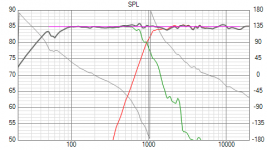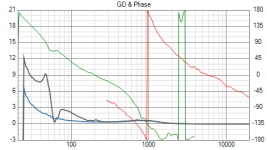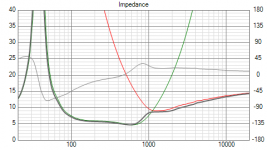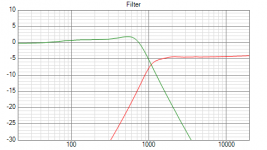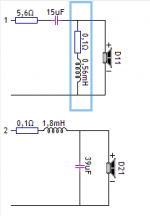Hello,
I almost finished the design of my speakers but I have a doubt about power.
The speakers are Monotoring type. I don't know yet if I will make them amplified or build a seperate amplifier espacially for it.
My question is, how do you determine the max power (based on RMS) of a 2 or 3 way speaker, depending on the drivers selected ?
I understand that it depends on the impedence of each driver. For example, if the woofer is 4 Ohms and the tweeter 8 Ohms, the woofer will receive 67% of the power and the tweeter 33%.
However, I also heard somewhere that it also depends on the frequency.
I'm a bit lost.
Basically, what is the rule to choose the amplifiers so that there is no risk for the tweeter or the amplifier itself ?
I was going to choose an amplifier with the power rating of the woofer but I want to be sure I won't burn the tweeter.
Thanks and have a nice day.
I almost finished the design of my speakers but I have a doubt about power.
The speakers are Monotoring type. I don't know yet if I will make them amplified or build a seperate amplifier espacially for it.
My question is, how do you determine the max power (based on RMS) of a 2 or 3 way speaker, depending on the drivers selected ?
I understand that it depends on the impedence of each driver. For example, if the woofer is 4 Ohms and the tweeter 8 Ohms, the woofer will receive 67% of the power and the tweeter 33%.
However, I also heard somewhere that it also depends on the frequency.
I'm a bit lost.
Basically, what is the rule to choose the amplifiers so that there is no risk for the tweeter or the amplifier itself ?
I was going to choose an amplifier with the power rating of the woofer but I want to be sure I won't burn the tweeter.
Thanks and have a nice day.
That would be true if the woofer and tweeter play the same frequency range and get the same input voltage. But it doesn't work that way. Music is a signal of which the power is distributed across all frequencies, with a bias towards low frequencies. How much power a driver will get depends on which frequency range it plays, its efficiency and how loud it is asked to play. And of course the spectral content of the music.
The signal that is going to the tweeter has got a high crest factor (peak to average power) and its amplifier must be sized based on the peaks. As the continuous power rating of a tweeter is only a few watts, it is almost always possible to damage the tweeter if you drive the amplifier into heavy clipping or if you play sine waves. It is not uncommon to drive an actively filtered 5 watt dome tweeter with a 50 watt amplifier. If you want to protect the tweeter from user errors, some form of limiter (placed before the amplifier) works.
If the crossover is passive, you could base the amplifier power rating on the woofer power rating, multiplied by some factor to account for the dynamic range of the signal. If the crossover is active, it gets more difficult.
The signal that is going to the tweeter has got a high crest factor (peak to average power) and its amplifier must be sized based on the peaks. As the continuous power rating of a tweeter is only a few watts, it is almost always possible to damage the tweeter if you drive the amplifier into heavy clipping or if you play sine waves. It is not uncommon to drive an actively filtered 5 watt dome tweeter with a 50 watt amplifier. If you want to protect the tweeter from user errors, some form of limiter (placed before the amplifier) works.
If the crossover is passive, you could base the amplifier power rating on the woofer power rating, multiplied by some factor to account for the dynamic range of the signal. If the crossover is active, it gets more difficult.
Last edited:
Is the crossover passive or active?
If passive you could use the following guideline. The loudspeaker input power is a bit larger than the woofer power handling.
If passive you could use the following guideline. The loudspeaker input power is a bit larger than the woofer power handling.
See section 7.5 https://www.jblpro.com/pub/manuals/pssdm_1.pdfJBL - Sound System Design Reference Manual said:A persistent question is: what amplifier power rating do I choose for use with a loudspeaker of a given power rating? The detailed answer is addressed in JBL’s Technical Note Volume 1, Number 16A; here, we will only summarize those recommendations:
1. For systems that will be stressed with full amplifier output for long periods of time, we recommend that the amplifier’s continuous output rating be chosen to be equal to the loudspeaker’s input power rating. Situations of this sort occur primarily in music reinforcement, where a constant, wide-band signal predominates.
2. For applications, such as speech reinforcement, where there is an operator who controls levels carefully, we can confidently recommend an amplifier with output capability that is twice (3 dB greater) than the loudspeaker’s continuous rating. The rational here is that peak power requirements, often slightly in excess of the loudspeaker’s continuous rating, can be handled with no problem, and it makes sense to provide amplification accordingly.
3. For certain critical monitoring applications, as in recording studios or film postproduction environments, amplifiers may be chosen that can deliver four-times (6 dB greater) power than the loudspeaker can withstand on a long-term continuous basis. The rational here is that the loudspeakers can ordinarily handle midrange and high frequency peaks of short duration that are much higher in instantaneous power than the long-term continuous rating of the loudspeaker.
Ah, I'm sorry, I did not check it.
Here it continuous. Section 7.5 is on page 25. http://www.jblpro.com/pub/manuals/pssdm_2.pdf
Here it continuous. Section 7.5 is on page 25. http://www.jblpro.com/pub/manuals/pssdm_2.pdf
Hello,
The drivers I chose are :
Woofer : Dayton Audio ES180TiA-8 7" Esoteric Series Woofer 8 Ohm
Tweeter : Peerless DA32TX00-08 1-1/4" Corundum Dome Tweeter
(To be honest, I'm thinking about changing because it comes more expensive that expected)
The box is designed with WinISD and I'm using a passive radiator to minimise the volume.
I use VituixCAD to design the crossover I came up with what's in the attached captures.
I didn't take care of phase yet, I need to get more knowledge about this to know what I'm doing.
Crossover frequency is around 1kHz.
I was planning on using a passive crossover but I found articles (ESP Projects for example) that says that Active Bi-Ampling makes all the difference.
About active cross-over, is it designed the same way but before the amplifier ?
Do you agree that it would be a better solution ?
Regarding to active crossover, I was thinking about a outside crossover + amp to save money.
Thanks,
Have a nice day.
The drivers I chose are :
Woofer : Dayton Audio ES180TiA-8 7" Esoteric Series Woofer 8 Ohm
Tweeter : Peerless DA32TX00-08 1-1/4" Corundum Dome Tweeter
(To be honest, I'm thinking about changing because it comes more expensive that expected)
The box is designed with WinISD and I'm using a passive radiator to minimise the volume.
I use VituixCAD to design the crossover I came up with what's in the attached captures.
I didn't take care of phase yet, I need to get more knowledge about this to know what I'm doing.
Crossover frequency is around 1kHz.
I was planning on using a passive crossover but I found articles (ESP Projects for example) that says that Active Bi-Ampling makes all the difference.
About active cross-over, is it designed the same way but before the amplifier ?
Do you agree that it would be a better solution ?
Regarding to active crossover, I was thinking about a outside crossover + amp to save money.
Thanks,
Have a nice day.
Attachments
A thing I'm not sure to understand :
For difference between active and passive, is it only that the crossover is placed before or after the amplifiers ?
Is it the same components or is a different filters ?
Thanks
There are several differences. Typical passive design, is with some larger passive components inside the speaker, that divide the frequency band into appropiate levels and frequency ranges for each driver. So the amplifier sees the whole frequency range, but the filter splits up - lets say - at 2500hz and above for the tweeter and 2500hz and below for the midrange/bass. Problem is with passive filters, is that they change with load and frequency. So the amplifier has a bigger job to manage and you cant be 100% sure that your original filter calculations are the same as what you hear, when playing music. It is also more difficult to manage the different components, to build a succesfull passive filter, that works in unity with the drivers and the amplifier you choose.
When going active. The main point is, that you have an amplifier dedicated to each driver, so that the amplifier sees only the coil in the driver, and no other passive components, that could alter performance.
Then you have a filter in front of the amplifier at line level, not at the higher power level from the output of the amplifier.
An active filter today is typically a DSP, that takes in a analog signal, converts it to digital, where it can manipulate the signal to almost anything you might want. Of course there are limits, because you have to convert back to analog before you can send the signal to the amplifiers.
So with a full range stereo signal. You can in the DSP, split it up at the before mentioned 2500hz and then send only the frequencies above and below this frequency, to its dedicated amplifier, for each driver. This way, you could have a smaller amplifier for the tweeter, since it newer sees any low frequencies, beacuse the DSP has filtered them away. And you could also use a more beefy amplifier for the bass, that might play a little louder, but in the DSP you set gain and EQ as well, so that the finished result is linear.
Of course there are limits and boundaries for everything, which you have to respect and understand, before you combine it all. But with the active system, you have potentially way more control and finesse, that with any passive design.
Oh - remember to measure. The acoustical output of a system is not always what you might have hoped for. You may have chosen filters of a certain type and so on. But the physical rules for the drivers, enclosure and room acoustics, are still king.
Hope you understand what I mean and that it was helpfull in some sense
One last thing. Active filter also - whether they are analog or digital - have input output buffers, so that they do not alter the signal comming in and out, with respect to impedance. Especially after the amplifier, it is important that active solution do not suffer from impedance matching, like passive designs do = No zobel network and so on are neccesary.
Last edited:
Thanks, I understand better now 
So active filter would be DSP and is a better solution than a cross-over before amp, right ?
About DSP, is it complicated to understand and design it ? I have absolutely no knowledge about this and I wonder if I need a long time to figure it out ?
Would you have a example of DSP module that would be suitable for :
- An external box Filtering + amp that's connected to two monitoring type speakers (So 2 stereo out - 4 RCA or BIG jack)
- A selection of source from (with knob selector)
- Bluetooth (I would had a small volume)
- Phono In (RCA)
- Line In (RCA)
- Small or big jack in
- A knob to control volume
- Eventually a "Mute" button.
- Eventually 2 outputs selection (Between RCA and XLR)
So active filter would be DSP and is a better solution than a cross-over before amp, right ?
About DSP, is it complicated to understand and design it ? I have absolutely no knowledge about this and I wonder if I need a long time to figure it out ?
Would you have a example of DSP module that would be suitable for :
- An external box Filtering + amp that's connected to two monitoring type speakers (So 2 stereo out - 4 RCA or BIG jack)
- A selection of source from (with knob selector)
- Bluetooth (I would had a small volume)
- Phono In (RCA)
- Line In (RCA)
- Small or big jack in
- A knob to control volume
- Eventually a "Mute" button.
- Eventually 2 outputs selection (Between RCA and XLR)
Thanks, I understand better now
So active filter would be DSP and is a better solution than a cross-over before amp, right ?
Activer filters are before amps - both DSP and active-analog. Old passive filters are AFTER amps, inside speakers.
About DSP, is it complicated to understand and design it ? I have absolutely no knowledge about this and I wonder if I need a long time to figure it out ?
Depends. It's more easy to create active filter, than passive, because you can change values directly in the software and need not to solder any physical components.
Would you have a example of DSP module that would be suitable for :
- An external box Filtering + amp that's connected to two monitoring type speakers (So 2 stereo out - 4 RCA or BIG jack)
- A selection of source from (with knob selector)
- Bluetooth (I would had a small volume)
- Phono In (RCA)
- Line In (RCA)
- Small or big jack in
- A knob to control volume
- Eventually a "Mute" button.
- Eventually 2 outputs selection (Between RCA and XLR)
You could buy a minidsp filter. Many people in here can explain it easily for you.
But if you do not want to have all the hasle. Then just buy a finished active monitor speaker. They are not that expensive and can be found with all the filters and amplifiers build in. You could ad a classic preamp, to control everything you want.
- Status
- This old topic is closed. If you want to reopen this topic, contact a moderator using the "Report Post" button.
- Home
- Loudspeakers
- Multi-Way
- Selecting Amp's power
